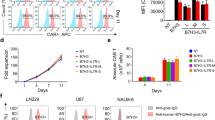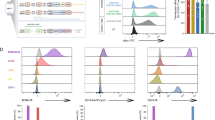Abstract
The functional state of CD8+ T cells determines the therapeutic efficacy of PD-1 blockade antibodies in tumors. Amino acids are key nutrients for maintaining T cell antitumor immunity. In this study, we used samples from lung cancer patients treated with PD-1 blockade antibodies to assay the amino acids in their serum by mass spectrometry. We found that lung cancer patients with high serum taurine levels generally responded to PD-1 blockade antibody therapy, in parallel with the secretion of high levels of cytotoxic cytokines (IFN-γ and TNF-α). CD8+ T cells cultured with exogenous taurine exhibited decreased apoptosis, enhanced proliferation, and increased secretion of cytotoxic cytokines. High SLC6A6 expression in CD8+ T cells was positively associated with an effector T cell signature. SLC6A6 knockdown limited the function and proliferation of CD8+ T cells. RNA sequencing revealed that SLC6A6 knockdown altered the calcium signaling pathway, oxidative phosphorylation, and T cell receptor signaling in CD8+ T cells. Furthermore, taurine enhanced T cell proliferation and function in vitro by stimulation of PLCγ1-mediated calcium and MAPK signaling. Taurine plus immune checkpoint blockade antibody significantly attenuated tumor growth and markedly improved the function and proliferation of CD8+ T cells in a mouse tumor model. Thus, our findings indicate that taurine is an important driver for improving CD8+ T cell immune responses and could serve as a potential therapeutic agent for cancer patients.







Similar content being viewed by others
Data availability
The datasets in current study are available from the corresponding author on reasonable request.
References
McLane LM, Abdel-Hakeem MS, Wherry EJ (2019) CD8 T cell exhaustion during chronic viral infection and cancer. Annu Rev Immunol 37:457–495. https://doi.org/10.1146/annurev-immunol-041015-055318
Zhang Z, Liu S, Zhang B, Qiao L, Zhang Y, Zhang Y (2020) T cell dysfunction and exhaustion in cancer. Front Cell Dev Biol 8:17. https://doi.org/10.3389/fcell.2020.00017
Im SJ, Hashimoto M, Gerner MY et al (2016) Defining CD8+ T cells that provide the proliferative burst after PD-1 therapy. Nature 537:417–421. https://doi.org/10.1038/nature19330
Abbas HA, Hao D, Tomczak K et al (2021) Single cell T cell landscape and T cell receptor repertoire profiling of AML in context of PD-1 blockade therapy. Nat Commun 12:6071. https://doi.org/10.1038/s41467-021-26282-z
Garcia de Moura R, Covre LP, Fantecelle CH et al (2021) PD-1 blockade modulates functional activities of exhausted-like T cell in patients with cutaneous leishmaniasis. Front Immunol 12:632667. https://doi.org/10.3389/fimmu.2021.632667
Pires da Silva I, Ahmed T, Reijers ILM et al (2021) Ipilimumab alone or ipilimumab plus anti-PD-1 therapy in patients with metastatic melanoma resistant to anti-PD-(L)1 monotherapy: a multicentre, retrospective, cohort study. Lancet Oncol 22:836–847. https://doi.org/10.1016/S1470-2045(21)00097-8
Sun JY, Zhang D, Wu S, Xu M, Zhou X, Lu XJ, Ji J (2020) Resistance to PD-1/PD-L1 blockade cancer immunotherapy: mechanisms, predictive factors, and future perspectives. Biomark Res 8:35. https://doi.org/10.1186/s40364-020-00212-5
Lei Q, Wang D, Sun K, Wang L, Zhang Y (2020) Resistance mechanisms of anti-PD1/PDL1 therapy in solid tumors. Front Cell Dev Biol 8:672. https://doi.org/10.3389/fcell.2020.00672
Ruiz de Galarreta M, Bresnahan E, Molina-Sanchez P et al (2019) Beta-Catenin activation promotes immune escape and resistance to anti-PD-1 therapy in hepatocellular carcinoma. Cancer Discov 9:1124–1141. https://doi.org/10.1158/2159-8290.CD-19-0074
Kim CG, Jang M, Kim Y et al (2019) VEGF-A drives TOX-dependent T cell exhaustion in anti-PD-1-resistant microsatellite stable colorectal cancers. Sci Immunol. https://doi.org/10.1126/sciimmunol.aay0555
Turiello R, Capone M, Morretta E et al (2022) Exosomal CD73 from serum of patients with melanoma suppresses lymphocyte functions and is associated with therapy resistance to anti-PD-1 agents. J Immunother Cancer. https://doi.org/10.1136/jitc-2021-004043
Shi R, Tang YQ, Miao H (2020) Metabolism in tumor microenvironment: Implications for cancer immunotherapy. MedComm 1:47–68. https://doi.org/10.1002/mco2.6
Yu W, Lei Q, Yang L, Qin G, Liu S, Wang D, Ping Y, Zhang Y (2021) Contradictory roles of lipid metabolism in immune response within the tumor microenvironment. J Hematol Oncol 14:187. https://doi.org/10.1186/s13045-021-01200-4
Gu M, Zhou X, Sohn JH et al (2021) NF-kappaB-inducing kinase maintains T cell metabolic fitness in antitumor immunity. Nat Immunol 22:193–204. https://doi.org/10.1038/s41590-020-00829-6
Chang CH, Qiu J, O’Sullivan D et al (2015) Metabolic competition in the tumor microenvironment is a driver of cancer progression. Cell 162:1229–1241. https://doi.org/10.1016/j.cell.2015.08.016
Bian Y, Li W, Kremer DM et al (2020) Cancer SLC43A2 alters T cell methionine metabolism and histone methylation. Nature 585:277–282. https://doi.org/10.1038/s41586-020-2682-1
Wu J, Li G, Li L, Li D, Dong Z, Jiang P (2021) Asparagine enhances LCK signalling to potentiate CD8(+) T-cell activation and anti-tumour responses. Nat Cell Biol 23:75–86. https://doi.org/10.1038/s41556-020-00615-4
Edwards DN, Ngwa VM, Raybuck AL et al (2021) Selective glutamine metabolism inhibition in tumor cells improves antitumor T lymphocyte activity in triple-negative breast cancer. J Clin Invest. https://doi.org/10.1172/JCI140100
Wen C, Li F, Zhang L, Duan Y, Guo Q, Wang W, He S, Li J, Yin Y (2019) Taurine is involved in energy metabolism in muscles, adipose tissue, and the liver. Mol Nutr Food Res 63:e1800536. https://doi.org/10.1002/mnfr.201800536
Nishio S, Negoro S, Hosokawa T et al (1990) The effect of taurine on age-related immune decline in mice: the effect of taurine on T cell and B cell proliferative response under costimulation with ionomycin and phorbol myristate acetate. Mech Ageing Dev 52:125–139. https://doi.org/10.1016/0047-6374(90)90119-z
Maher SG, Condron CE, Bouchier-Hayes DJ, Toomey DM (2005) Taurine attenuates CD3/interleukin-2-induced T cell apoptosis in an in vitro model of activation-induced cell death (AICD). Clin Exp Immunol 139:279–286. https://doi.org/10.1111/j.1365-2249.2005.02694.x
Dong JF, Zheng XQ, Rui HB (2017) Effect of taurine on immune function in mice with T-cell lymphoma during chemotherapy. Asian Pac J Trop Med 10:1090–1094. https://doi.org/10.1016/j.apjtm.2017.10.014
Kaesler S, Sobiesiak M, Kneilling M et al (2012) Effective T-cell recall responses require the taurine transporter Taut. Eur J Immunol 42:831–841. https://doi.org/10.1002/eji.201141690
Wang W, Zou W (2020) Amino acids and their transporters in T cell immunity and cancer therapy. Mol Cell 80:384–395. https://doi.org/10.1016/j.molcel.2020.09.006
Ganesan AP, Clarke J, Wood O et al (2017) Tissue-resident memory features are linked to the magnitude of cytotoxic T cell responses in human lung cancer. Nat Immunol 18:940–950. https://doi.org/10.1038/ni.3775
Guo X, Zhang Y, Zheng L et al (2018) Global characterization of T cells in non-small-cell lung cancer by single-cell sequencing. Nat Med 24:978–985. https://doi.org/10.1038/s41591-018-0045-3
Miller BC, Sen DR, Al Abosy R et al (2019) Subsets of exhausted CD8(+) T cells differentially mediate tumor control and respond to checkpoint blockade. Nat Immunol 20:326–336. https://doi.org/10.1038/s41590-019-0312-6
Kumagai S, Togashi Y, Kamada T et al (2020) The PD-1 expression balance between effector and regulatory T cells predicts the clinical efficacy of PD-1 blockade therapies. Nat Immunol 21:1346–1358. https://doi.org/10.1038/s41590-020-0769-3
Ren D, Hua Y, Yu B et al (2020) Predictive biomarkers and mechanisms underlying resistance to PD1/PD-L1 blockade cancer immunotherapy. Mol Cancer 19:19. https://doi.org/10.1186/s12943-020-1144-6
Gu SS, Zhang W, Wang X et al (2021) Therapeutically increasing MHC-I expression potentiates immune checkpoint blockade. Cancer Discov 11:1524–1541. https://doi.org/10.1158/2159-8290.CD-20-0812
Hope HC, Salmond RJ (2021) The role of non-essential amino acids in T cell function and anti-tumour immunity. Arch Immunol Ther Exp (Warsz) 69:29. https://doi.org/10.1007/s00005-021-00633-6
Sugimoto M, Wong DT, Hirayama A, Soga T, Tomita M (2010) Capillary electrophoresis mass spectrometry-based saliva metabolomics identified oral, breast and pancreatic cancer-specific profiles. Metabolomics 6:78–95. https://doi.org/10.1007/s11306-009-0178-y
Qaradakhi T, Gadanec LK, McSweeney KR, Abraham JR, Apostolopoulos V, Zulli A (2020) The anti-inflammatory effect of taurine on cardiovascular disease. Nutrients. https://doi.org/10.3390/nu12092847
Jakaria M, Azam S, Haque ME, Jo SH, Uddin MS, Kim IS, Choi DK (2019) Taurine and its analogs in neurological disorders: Focus on therapeutic potential and molecular mechanisms. Redox Biol 24:101223. https://doi.org/10.1016/j.redox.2019.101223
Froger N, Moutsimilli L, Cadetti L et al (2014) Taurine: the comeback of a neutraceutical in the prevention of retinal degenerations. Prog Retin Eye Res 41:44–63. https://doi.org/10.1016/j.preteyeres.2014.03.001
Ansar M, Ranza E, Shetty M et al (2020) Taurine treatment of retinal degeneration and cardiomyopathy in a consanguineous family with SLC6A6 taurine transporter deficiency. Hum Mol Genet 29:618–623. https://doi.org/10.1093/hmg/ddz303
Meng L, Lu C, Wu B et al (2021) Taurine antagonizes macrophages M1 polarization by mitophagy-glycolysis switch blockage via dragging SAM-pp2ac transmethylation. Front Immunol 12:648913. https://doi.org/10.3389/fimmu.2021.648913
Prideaux M, Kitase Y, Kimble M, O’Connell TM, Bonewald LF (2020) Taurine, an osteocyte metabolite, protects against oxidative stress-induced cell death and decreases inhibitors of the Wnt/beta-catenin signaling pathway. Bone 137:115374. https://doi.org/10.1016/j.bone.2020.115374
Yang L, Dedkova EN, Allen PD, Jafri MS, Fomina AF (2021) T lymphocytes from malignant hyperthermia-susceptible mice display aberrations in intracellular calcium signaling and mitochondrial function. Cell Calcium 93:102325. https://doi.org/10.1016/j.ceca.2020.102325
Zeng XZ, Zhang YY, Yang Q, Wang S, Zou BH, Tan YH, Zou M, Liu SW, Li XJ (2020) Artesunate attenuates LPS-induced osteoclastogenesis by suppressing TLR4/TRAF6 and PLCgamma1-Ca(2+)-NFATc1 signaling pathway. Acta Pharmacol Sin 41:229–236. https://doi.org/10.1038/s41401-019-0289-6
Gao Y, Lin H, Guo D et al (2021) Suppression of 4.1R enhances the potency of NKG2D-CAR T cells against pancreatic carcinoma via activating ERK signaling pathway. Oncogenesis 10(9):1–9. https://doi.org/10.1038/s41389-021-00353-8
Huang MY, Jiang XM, Wang BL, Sun Y, Lu JJ (2021) Combination therapy with PD-1/PD-L1 blockade in non-small cell lung cancer: strategies and mechanisms. Pharmacol Ther 219:107694. https://doi.org/10.1016/j.pharmthera.2020.107694
Yi M, Zheng X, Niu M, Zhu S, Ge H, Wu K (2022) Combination strategies with PD-1/PD-L1 blockade: current advances and future directions. Mol Cancer 21:28. https://doi.org/10.1186/s12943-021-01489-2
Zhu Y, Chen M, Xu D et al (2022) The combination of PD-1 blockade with interferon-alpha has a synergistic effect on hepatocellular carcinoma. Cell Mol Immunol. https://doi.org/10.1038/s41423-022-00848-3
Wu M, Huang Q, Xie Y, Wu X, Ma H, Zhang Y, Xia Y (2022) Improvement of the anticancer efficacy of PD-1/PD-L1 blockade via combination therapy and PD-L1 regulation. J Hematol Oncol 15:24. https://doi.org/10.1186/s13045-022-01242-2
Acknowledgements
We thank Henan Key Laboratory for Pharmacology of Liver Diseases for assistance with animal experiments.
Funding
This work was supported by the National Natural Science Foundation of China (Grant nos. 82102869, 81872333 and 91942314), Medical Science and Technology Project of Henan Province (Grant no. SBGJ202103083), China Postdoctoral Science Foundation (Grant no. 2021M692928), and Excellent Youth Project for Health talents in Henan Province (Grant No. YXKC2020052).
Author information
Authors and Affiliations
Contributions
All authors contributed to the study conception and design. This study was designed and supervised by YZ and YP. Data collection and analysis were performed by YP, JS, FL, LW and ZL. Material preparation was performed by YL, JL, DY and LW. The first draft of the manuscript was written by YP. The manuscript was edited by XC and YZ. All authors commented on previous versions of the manuscript. All authors read and approved the final manuscript.
Corresponding author
Ethics declarations
Competing interests
The authors declare no competing interests.
Conflict of interests
The authors have no relevant financial or non-financial interests to disclose.
Ethical approval
This study was approved by the Ethics Committee of the First Affiliated Hospital of Zhengzhou University (2021-KY-1105–002).
Informed consent
Informed consent was obtained from all individual participants included in the study.
Human or animal rights
All animal experiments were approved by the Animal Care and Ethics Committee of the First Affiliated Hospital of Zhengzhou University.
Additional information
Publisher's Note
Springer Nature remains neutral with regard to jurisdictional claims in published maps and institutional affiliations.
Supplementary Information
Below is the link to the electronic supplementary material.
Rights and permissions
Springer Nature or its licensor (e.g. a society or other partner) holds exclusive rights to this article under a publishing agreement with the author(s) or other rightsholder(s); author self-archiving of the accepted manuscript version of this article is solely governed by the terms of such publishing agreement and applicable law.
About this article
Cite this article
Ping, Y., Shan, J., Liu, Y. et al. Taurine enhances the antitumor efficacy of PD-1 antibody by boosting CD8+ T cell function. Cancer Immunol Immunother 72, 1015–1027 (2023). https://doi.org/10.1007/s00262-022-03308-z
Received:
Accepted:
Published:
Issue Date:
DOI: https://doi.org/10.1007/s00262-022-03308-z




